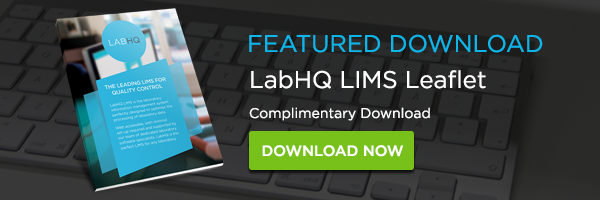 Overheard in the ABC Pharmaceuticals QC lab, "He understands the regulatory benefits of LIMS, but my boss also wants to see a tangible return on investment. Help!"
Overheard in the ABC Pharmaceuticals QC lab, "He understands the regulatory benefits of LIMS, but my boss also wants to see a tangible return on investment. Help!"
A major driver for implementing LIMS in regulated industries is the increasing focus of the MHRA, FDA & HPRA on the hot topic of data integrity. Failure to present a quality system that meets the requirements reflected in the ALCOA acronym ( data must be attributable, legible (permanent), contemporaneous, original and accurate) could lead to a loss of licence and result in a devastating impact on revenue.
However, in the increasingly cost conscious world in which we operate, how can you also show that all important return on LIMS investment that every board in the land will demand?
The obvious place to start is by identifying the savings derived directly from LIMS due to time and labour reduction in the sample workflow management process.
-
Start by identifying the sample management processes (Process Mapping is a great way to achieve this).
-
Once identified, track an actual sample and identify the time taken to complete each step in the process. Add them together to get the total time taken to process a test sample.
-
Do the same based on the post LIMS estimation. Remember that LIMS may fully automate some steps in the process (for example, by facilitating direct result entry via instrument interfaces).
-
Subtract the post LIMS processing time from the pre LIMS time to calculate the saving per sample.
-
Extrapolate the savings over the total number of samples processed/month or year.
-
Multiply the savings by the fully loaded costs (salary plus benefits) to derive direct sample processing cost savings.
Do not fall into the trap of thinking that this is where the savings end. Other, less obvious, savings include:
-
Productivity gains and reduced product rejections by acting on interpretation of test data.
-
For example, make sure your LIMS can generate trend charts. At the press of a button you can display production trend information enabling you to put corrective actions in place if a parameter is heading out of limit.
-
-
Immediate transfer of test data to other departments.
-
Faster report production.
-
Stationery cost savings.
-
Immediate access to data. How much time do you currently spend accessing data from that archive store?
-
Avoiding the impact of calculation errors.
-
Facilitating audits.
-
The security of electronic data capture.
You can expect to double the value of direct savings, and often generate even more.
If this seems like too much for you to do on your own, there are organisations out there that can help. Make sure they are:
-
Experts in LIMS, laboratory work processes and laboratory data and information flow.
-
Domain experts (i.e. your industry and your type of lab).
-
IT experts.
-
Regulatory experts (if your lab is in a regulated environment).






